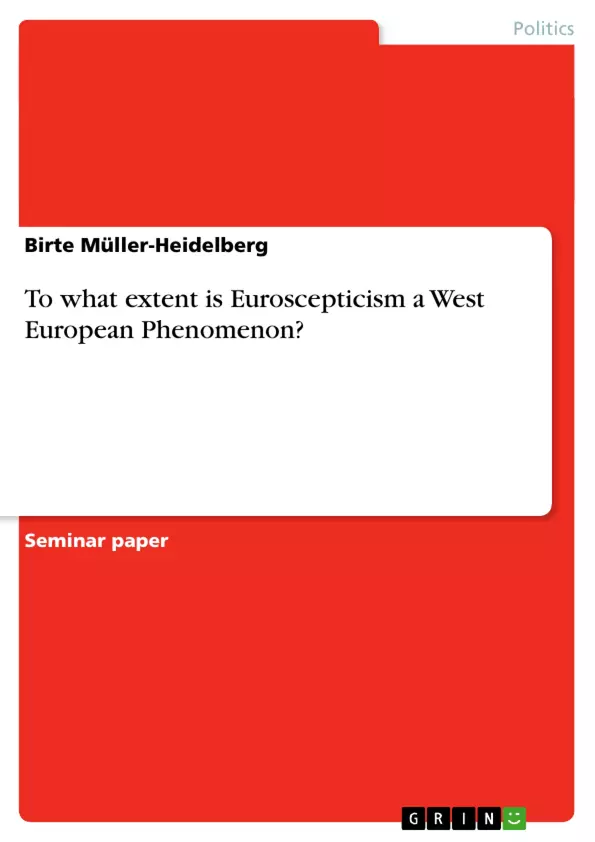[...] This essay will show however that Euroscepticism is not a purely Western phenomenon. By taking a closer look at the latest Eurobarometer surveys (chapter 2) and then examining possible reasons for an upcoming Euroscepticism in the candidate countries (chapter 3), mainly focussing on Poland and the Czech Republic, the conclusion will try to differentiate between the form of Euroscepticism found in the Western states that already are members of the Union and the countries in the East that will join in May 2004 or are still negotiating. In the following analysis, a distinction between hard and soft Euroscepticism will be made. The former, also called principled Euroscepticism, encompasses outright rejection of the EU integration project and is in opposition to the respective country’s joining or staying in the Union. The latter, frequently termed contingent Euroscepticism as well, can be either concerning the policies (overall support of EU integration but critical to the transfer of power to a European level in certain areas) or the national interest (defending the national interest while supporting the overall integration). While hard Euroscepticism would not allow any European integration, soft Euroscepticism remains “compatible with the spirit of the EU project” because it’s qualified rather than absolute and therefore resolvable through negotiations.7 Hard Euroscepticism is hardly found at all; even the British do not really want to leave the European Union and could therefore be classified as soft Eurosceptics.8 Although there is research on the fields of party-based Euroscepticism as well as Euroscepticism in public opinion, this essay will not explicitly differentiate between the two because they go hand in hand when analysing the question whether there is any Euroscepticism in Central and Eastern Europe at all. The obvious Euroscepticism in Western countries could be linked closely to the fact that they have been members of the Union for quite a long time by now. [...] 7 Lees, 2002, 250 8 Baker, 2003, 237
Inhaltsverzeichnis (Table of Contents)
- Introduction - Euroscepticism in Western Europe
- Public Opinion in Central and Eastern Europe
- Reasons for Euroscepticism in Central and Eastern Europe
- Poland
- The symbolic character of the European Union - waking up from a dream
- The Czech Republic
- Conclusion Euroscepticism, an overall phenomenon
Zielsetzung und Themenschwerpunkte (Objectives and Key Themes)
This essay seeks to explore the extent to which Euroscepticism is a phenomenon primarily associated with Western Europe. By examining public opinion data from Eurobarometer surveys and investigating possible reasons for growing Euroscepticism in Central and Eastern Europe, particularly Poland and the Czech Republic, the essay aims to differentiate between the types of Euroscepticism found in existing member states and those in countries about to join or still negotiating entry.
- The nature and prevalence of Euroscepticism in Western Europe
- Public opinion towards EU membership in Central and Eastern Europe
- Potential reasons for Euroscepticism in candidate countries
- The distinction between hard and soft Euroscepticism
- The impact of geographical proximity on EU membership attitudes
Zusammenfassung der Kapitel (Chapter Summaries)
- Introduction - Euroscepticism in Western Europe: This chapter introduces the concept of Euroscepticism, particularly focusing on the case of the United Kingdom, where it is frequently perceived as a prominent issue. The chapter explores various arguments and perspectives on the EU's perceived shortcomings, including concerns about a lack of democracy, excessive regulation, corruption, and potential negative consequences for national interests. It also introduces the distinction between hard and soft Euroscepticism, highlighting that even in Western Europe, outright rejection of the EU integration project is rare.
- Public Opinion in Central and Eastern Europe: This chapter analyzes recent Eurobarometer polls, challenging the common perception of a clear-cut East-West divide regarding Euroscepticism. The chapter presents data demonstrating that both Eastern and Western countries exhibit a range of attitudes towards EU membership, with some Eastern countries expressing higher levels of support compared to certain Western countries. This analysis challenges the notion that Central and Eastern European countries are uniformly enthusiastic about EU membership.
Schlüsselwörter (Keywords)
This essay examines Euroscepticism, public opinion, EU integration, Central and Eastern Europe, candidate countries, member states, hard and soft Euroscepticism, Eurobarometer surveys, Poland, Czech Republic, national interest, EU policies, democratic deficit, regulation, corruption.
- Citar trabajo
- Birte Müller-Heidelberg (Autor), 2003, To what extent is Euroscepticism a West European Phenomenon?, Múnich, GRIN Verlag, https://www.grin.com/document/26871



